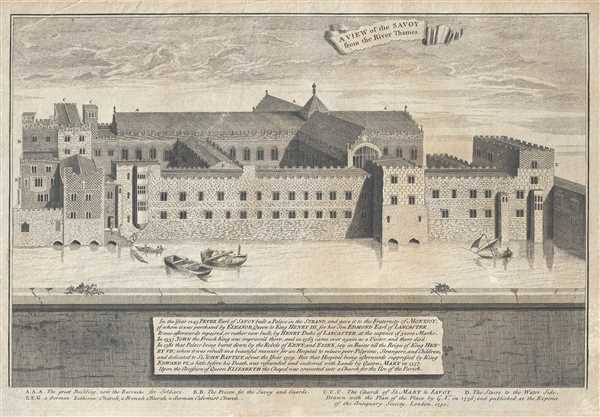1750 Vertue Print of Savoy Hospital, London
Savoy-vertue-1750
Title
1750 (dated) 13 x 18 in (33.02 x 45.72 cm)
Description
The Savoy, better known as the Savoy Palace, was considered the grandest nobleman's townhouse in medieval London and stood between the Strand and that Thames River. The Strand, the most desirable location for housing nobility during the Middle Ages, was situated along the ceremonial route between the city and the Palace of Westminster, where the business of parliament and the royal court took place. In 1246 King Henry III granted the land between the Strand and the Thames to Peter, the Count of Savoy, who built a house there. The house became the home of Edmund, the Earl of Lancaster, and his descendants, the Dukes of Lancaster. In the 14th century, it became the home of John of Gaunt, a younger son of King Edward III who had inherited by marriage the title and lands of the Dukes of Lancaster. The house was destroyed during the Peasants' Revolt in 1381, because the rioters blamed John of Gaunt for the introduction of the poll tax that had instigated the revolt. The house and everything in it was systematically destroyed; everything was either smashed, burned, or thrown in the river. Despite this, the name Savoy was retained by the site. It was on this site that, in 1512, Henry VII founded the Savoy Hospital, which is what is depicted in the current engraving by George Vertue's. It became the most impressive hospital in the country and the first to benefit from permanent medical staff. In 1642, it was reassigned as a military hospital before being converted into barracks in 1679. The Savoy Hospital was destroyed by a fire during the 18th century. A hundred years later, during the 19th century, all of the remaining hospital buildings were demolished, with the exception of the chapel, which remains standing today. The caption at the bottom of the print gives a brief history of the Savoy, when it was built and by whom, how the house changed hands, and how it was ruined during the riots. The caption also includes when it was rebuilt and how it's function changed until the engraving was commissioned. Within the image, each part of the Savoy is labeled with letters corresponding to descriptive text at the bottom of the print. There is also a small inscription which reads,
Drawn with the Plan of the Place by G.V. (George Vertue) in 1736; and published at the Expence of the Antiquary Society, London, 1750.This print was plate 12 in the second volume of Vetusta Monumenta as well, which was originally published in 1789. The plates for the volumes were released individually before the volumes were assembled. The plates for the second volume were published between 1748 and 1789.
Cartographer
George Vertue (1684-1756) was an English engraver born in London. As a young man he apprenticed as an engraver for several years before beginning to work independently. He had an avid interest in antiquarian research and accumulated about forty volumes of notebooks about the details of the history of British art, which serve as an important research for contemporary knowledge on the subject. In 1717 he was appointed as the official engraver of the Society of Antiquaries, of which he was a founding member. Most of the illustrations in the Vetusta Monumenta, until his death, are his work. Vertue was also a portraitist, with approximately 500 portraits attributed to him. A similar number of plates devoted to antiquarian subjects were also published in his name. More by this mapmaker...

